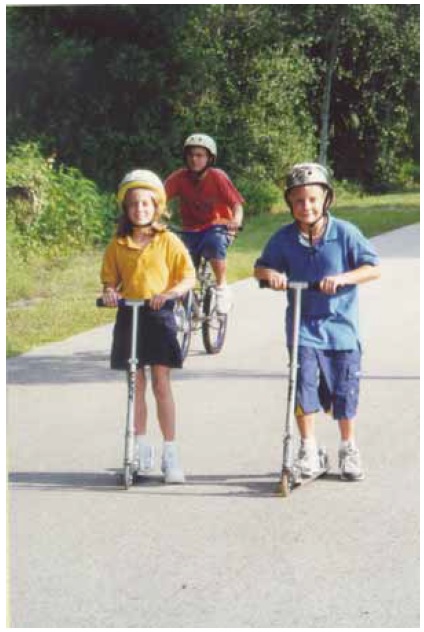Nonmotorized Kick Scooters
The most common nonmotorized kick scooters have approximately 100-mm (4-inch) diameter polyurethane wheels like those on inline skates (figure 2). The platform is usually relatively short and too narrow (100 mm (4 inches)) for two feet side by side. Larger nonmotorized scooters with bigger platforms and 150-mm to 300-mm (6- to 12-inch) wheels with polyurethane or rubber tires are also available. These larger scooters are currently less prevalent, but because they provide more utility due to improved efficiency, several manufacturers are developing and promoting larger models.

Figure 2. Nonmotorized kick scooters.
Two braking systems are common. Smaller, less expensive scooters have an articulated fender over the rear wheel that can be stepped on to create friction with the wheel. Larger models have a hand brake much like the brakes used on bicycles. A few inexpensive models have no brakes; users simply step on the rear wheel with their shoes or skid their feet on the ground.
Nonmotorized kick scooter use in the United States has increased phenomenally in the past several years. Although very few were sold in 1999, it was estimated that approximately 5 million scooters were sold in the United States in 2000.(10) As expected, scooter crashes have increased significantly as well. The U. S. Consumer Product Safety Commission (CPSC) reported a 13-fold increase in emergency-room-treated scooter injuries between the first and second half of 2000, from 2,820 to 37,750.(11)
Operational characteristics for nonmotorized scooters depend on many factors, including the abilities of the user and the design of the scooter. For example, a nonmotorized scooter with large aluminum wheels has lower rolling resistance than a scooter with small inline skate-type wheels, potentially resulting in faster acceleration rates and higher speeds. It is likely that the different braking systems result in different stopping distances and deceleration rates. Scooters likely have varying maneuverability, as well.
10. Rutherford, Jr. G. W. and R. Ingle. Unpowered Scooter-Related Injuries-United States, 1998-2000. CDC MMWR Weekly, Vol. 49, No. 49, December 15, 2000, pp. 1108-1110. www.cdc.gov/mmwr/preview/mmwrhtml/mm4949a2.htm. Accessed August 10, 2001.
11. Consumer Product Safety Commission. Motorized scooter use increases and injuries climb. Press release, August 22, 2001. www.cpsc.gov/CPSCPUB/PREREL/prhtml01/01222.html

User Comments/Questions
Add Comment/Question